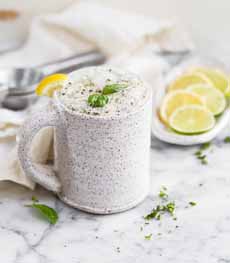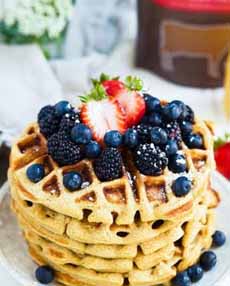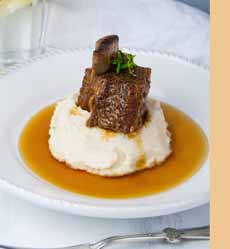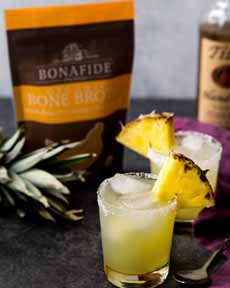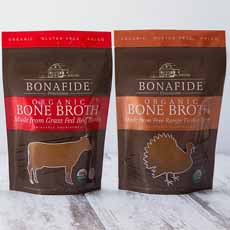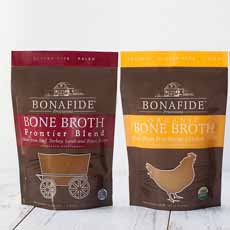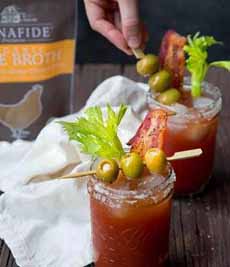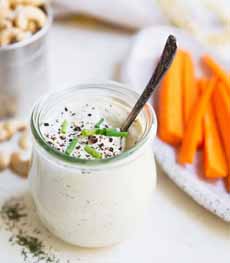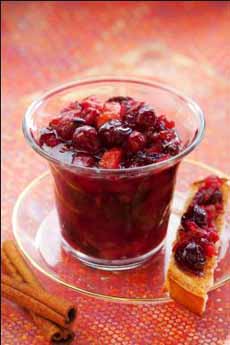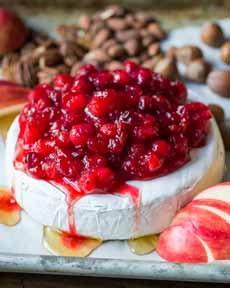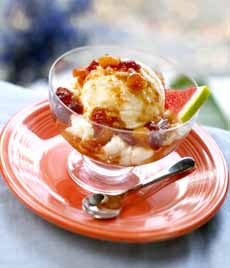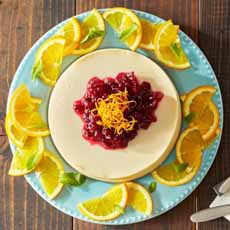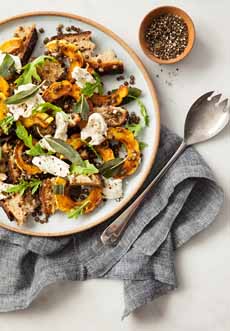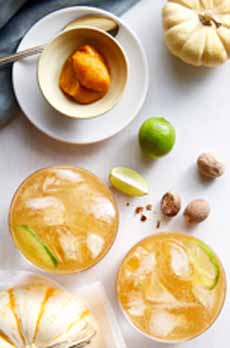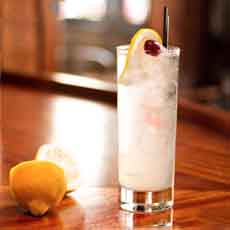|
November 3rd is National Sandwich Day (August is National Sandwich Month).
Since grandma’s day, the American sandwich has evolved from meat, cheese or fish, on bread or a roll, with a schmear of mustard or mayo, to…anything goes.
Here’s what some of America’s chefs are doing with sandwich spreads, courtesy of Flavor And The Menu, a magazine that keeps chefs up-to-date on what their colleagues are doing nationwide.
But first:
The History Of The Sandwich
Sandwich Glossary: The Different Types Of Sandwiches
SANDWICH SPREADS: 10 FLAVOR UPGRADES
“Condiments, spreads and dressings are the hidden heroes of today’s sandwich innovation,” begins the article.
If your favorite sandwich condiment is mustard or mayonnaise, it’s time for a flavor upgrade.
1. AÏOLI & OTHER FLAVORED MAYONNAISE (Photos #1 and #4)
Mayonnaise is a favorite condiment. In France, it takes the form of aïoli, garlic mayonnaise.
The past two decades have seen an explosion of flavors: bacon, basil, cayenne, chipotle, curry, horseradish and down through the alphabet, ending with wasabi. You can buy them or make them, by adding your flavor of choice to regular mayonnaise.
Chef examples:
Woodrow’s Whiz Wit: shaved ribeye, truffle whiz, caramelized onion, cherry pepper mayo, at Woodrow’s Sandwich Shop in Philadelphia.
BBLT: Double bacon, lettuce and tomato with black pepper balsamic mayo on toasted sourdough, at Penelope in New York.
Korean Fried Chicken Sandwich: red chile buttermilk, lime kimchi slaw, gochujang aïoli, at Keoki’s Paradise, Koloa, Hawaii.
Try these ideas:
Mix olives, capers, pickles, sun-dried tomatoes, specialty mustard, balsamic, or another full-flavored ingredient into mayo or aïoli for an easy flavor fix.
Explore mayonnaise-based sauces like rémoulade, gribiche (chopped hard-boiled egg yolks emulsified into oil), or Louis sauce (heavy cream, chile sauce, minced onion and bell pepper, Worcestershire, garlic, and lemon juice and zest).
2. CHUTNEY (Photo #2)
India’s spiced condiments boost flavor in sweet (fruit) or savory (herb or vegetable) variations.
Chef examples:
Paneer Kathi Wrap: paneer cheese with red and green peppers and mint chutney at Chauhan Ale & Masala House in Nashville. (A kathi or kati wrap is made from paratha bread.)
Chutney Chicken Salad Sandwich: chicken breast, celery, peanuts and mango chutney on a fresh poppyseed roll with mayo, cucumber slices, shredded carrots, tomatoes and lettuce at Uptown Cafe and Catering in Tallahassee, Florida.
Ham or turkey with mango chutney, roast beef with coriander chutney, at The Nibble offices in New York City.
Try this idea:
Make your own chutney using seasonal fruits and vegetables. It can become your signature condiment, and you can make extra for gifts.
3. CLASSIC SAUCES
The classic French mother sauces and secondary sauces can be ported to sandwiches—especially warmed.
Chef examples:
Le Royale Burger: with cheese, foie gras, Bordelaise sauce, Gruyère melt, onion confit and black truffle at Pubbelly Noodle Bar in Miami Beach.
Shaved Roast Beef: sauce Béarnaise and fried onions at DoveCote Brasserie in Orlando, Florida.
Try these ideas:
Variations: A mother sauce like béchamel can be endlessly varied to suit a sandwich’s other ingredients. Vary the basic recipe with cheese, sautéed mushrooms, onions, mustard, etc.
Warm sauce: Using a warm or hot sauce on a cold or room-temperature sandwich adds the element of contrasting temperatures.
4. GLOBAL SAUCES (Photo #3)
Is there an area of the world that hasn’t sent its condiments and spices to the U.S.?
From a gochujang-spiked mayo to curry ketchup, globally flavored condiments add a touch of the exotic to the familiar sandwich.
Chef examples:
Harissa Grilled Chicken Sandwich: grilled chicken breast with slightly spicy harissa aïoli and Swiss cheese, on a housemade bun with lettuce, onion and pickles, at The Farm Bistro in, Cortez, Colorado.
Crispy Buttermilk Fried Chicken: Sandwich with sharp cheddar, tomato and kimchi aïoli, at Wardon Hall in South Boston, Massachusetts.
Bacon, Egg and Harissa Sandwich: with harissa aïoli, at 112 Eatery in Minneapolis
Try these ideas:
Romesco, a Spanish sauce of nuts and red peppers, adds color and flavor to vegetarian, fish and chicken sandwiches.
Toss chicken salad in nam pla-(Thai fish sauce)-spiked mayonnaise, for an umami-laced Asian twist.
5. JAM (Photo #5)
Sweet and savory jams are right at home on a sandwich.
Chef examples:
Morning, Noon & Night Melt: bacon, ham, two fried eggs, apricot-bacon jam and American cheese on sourdough, at Kings in Pennsylvania and Ohio.
The European: sharp cheddar, arugula and blueberry-tarragon jam on baguette, at Succotash, Kansas City, Missouri.
Try these ideas:
|
|
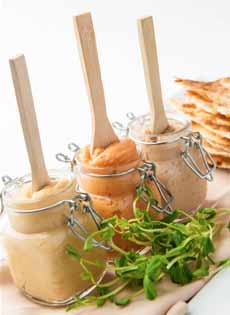
[1] Three flavored mayos: garlic aoili, harissa and Dijon, from Chef Eric Levine.
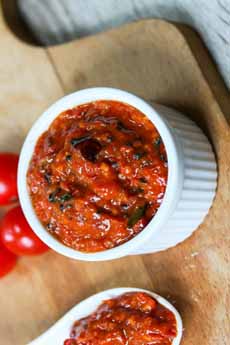
[2] Try chutney, sweet or savory, as a sandwich spread. Here’s the recipe for this tomato chutney from NDTV.
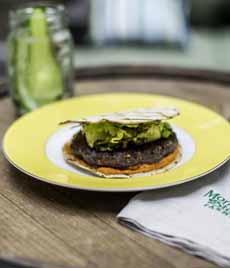
[3] Burger with romesco sauce, from Morningstar Farms.

[4] A grilled pineapple BLT with sriracha mayo, at Half Baked Harvest.

[5] Jam as a touch of sweetness to a sandwich, and there are so many different pairings (photo courtesy Lexi’s Clean Kitchen).

[6] The classic pasta sauce also works as a sandwich spread. Use a chunkier style (less dripping with olive oil—photo Looby | IST).
|
|
Spread marmalade, with its bitter edge of citrus peel, on hearty meat-based sandwiches, such as brisket or ham.
Experiment with seasonal fruits in jams, jellies, and other preserves, from rhubarb and strawberry in the spring to pears, quince and apples in the fall.
6. PESTO (Photo #6)
This familiar pasta sauce can be made in many ways—changing the herb, nuts and cheese—to suit any sandwich.
Chef examples:
Caprese: fresh mozzarella, roasted tomato, kale pesto, balsamic reduction at Roxy’s Grilled Cheese, multiple locations in Boston area.
Chelsea Lo-Cal: two eggs, turkey bacon, roasted red peppers, broccoli rabe, Greek yogurt and walnut pesto sauce on multi-grain toast, at BEC in New York.
Try these ideas:
Make pesto with different herbs—cilantro, parsley, tarragon—or vegetables such as spinach, arugula, kale, celery leaves, roasted red pepper, zucchini or pumpkin purée.
Fold pesto into mayonnaise, softened butter, cream or other fresh cheese, hummus or another sandwich spread.
|
|
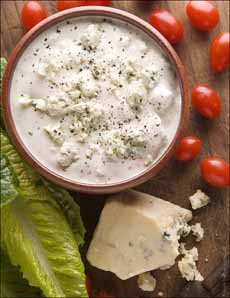
[6] Blue cheese dressing: great on burgers and many sandwiches (photo ©Picture-Perfect Meals).

[7] Tahini sauce, thick and spreadable (it’s diluted to make a sauce—photo Fotographica Basica | IST).

[8] Blue cheese dressing: great on burgers and many sandwiches (photo ©Picture-Perfect Meals).

[9] Add a fried egg to cold cuts, vegetarian sandwiches, anything you like (photo © Safe Eggs).
|
|
7. SALAD DRESSING (Photo #6)
Using salad dressing on a sandwich is not a new idea: Think Reuben and Russian dressing.
Chef ideas:
Blackened Halloumi Sandwich: spicy Cajun-blackened grilled halloumi on a telera roll with fresh spinach, cucumbers and blue cheese dressing, at Seva in Ann Arbor, Michigan.
Green Goddess Chicken Sandwich: grilled chicken with green goddess dressing, at Willy Street Co-op in Madison and Middletown, Wisconsin.
Try these ideas:
Substitute plain or flavored ranch dressing for the mayonnaise in egg, tuna or chicken salad sandwiches.
Use ginger-miso dressing in a vegetable wrap sandwich for an Asian twist.
8. TAHINI (Photo #7)
This smooth condiment and sauce is made from ground sesame seeds. It is a key ingredient in hummus, baba ghanouj and halvah, but it’s also coming into its own as a sandwich spread.
Chef examples:
Shawarma Bomb: chicken, sriracha sauce, jalapeño, pickle, tomato, onion and tahini sauce at Hummus Café in Morrisville, North Carolina.
Steak Sandwich: Prime cuts of tender seasoned steak wrapped in a pita with tahini, at Jerusalem in Denver.
Try these ideas:
Boost the flavor of tahini—and turn it into a colorful green shade—with the addition of chopped herbs such as parsley, dill, chives, cilantro and/or mint.
For a snack and for kids, make an open-face pita, tahini and sliced-apple sandwich on multigrain bread with a drizzle of honey or maple syrup.
9. TAPENADE (Photo #8)
Tapenade is a Provençal specialty made from puréed or finely chopped olives, capers and olive oil. It hits all the right flavor notes, and works with a broad selection of sandwich ingredients.
Chef examples:
Turkey Tapenade: olive tapenade, avocado, tomatoes, pesto aïoli and bibb lettuce at Parlor 1255 in San Francisco.
T.L.C.: cucumber steaks, roasted tomatoes, artichoke hearts, red onion, spinach and olive tapenade, served on toasted pumpernickel at The Brown Bag Delicatessen in Columbus, Ohio.
Try these ideas:
Boost the flavor of vegetarian sandwiches—grilled vegetable, portobello mushroom, falafel, or goat cheese, tomato and cucumber—with a schmear of tapenade.
Make the olive mixture more interesting with the addition of artichoke hearts, sun-dried or oven-roasted tomatoes, dried figs or currants or chopped nuts. You can also spice it up with chili flakes or harissa.
10. YOGURT
This tangy, good-for-you ingredient has long been served as tzatziki (with chopped cucumber and mint), in gyro shops. Thankfully, it has traveled further.
Chef examples:
Turkey Gyro LTO: thinly-sliced roast turkey, lettuce, onions and tomatoes with tzatziki sauce and traditional gyro seasonings on soft pita, at Arby’s, all locations.
Spinach Falafel Shawarma: with beet tzatziki, arugula and pickles at Sofra Bakery & Cafe in Cambridge, Massachusetts.
Todd: smoked Portuguese pancetta, seasonal lettuce, tomato and honey Dijon yogurt sauce at City Sandwich in New York.
Grilled Chicken Sandwich, or ham, turkey, or roast beef with tzatziki, at The Nibble offices in New York City.
Try these ideas:
Flavor yogurt with garlic, Parmesan, basil and hot pepper or with avocado, ginger, soy and wasabi to dress chicken, fish or vegetable-filled sandwiches.
Greek yogurt is extra thick, extra flavorful, and can be a condiment or sauce plain or with added garlic and/or herbs.
|
11. FRIED OR POACHED EGG (Photo #9)
Flavor & The Menu didn’t include this one on their list, but it’s an option we use regularly: a fried (up, over, hard) or poached egg.
It adds flavor and texture to many sandwiches, including burgers. It gave its name to the BLTE—bacon, lettuce, tomato and egg (usually fried over) sandwich.
It’s great with everything from avocado toast to chicken/turkey to roast vegetables.
In photo #9, it’s on a hero. Give it a try!
Strut your sandwich!
|
|
